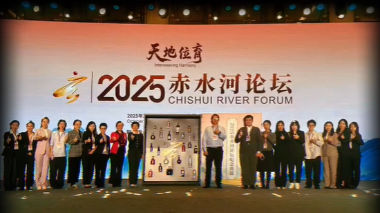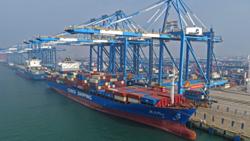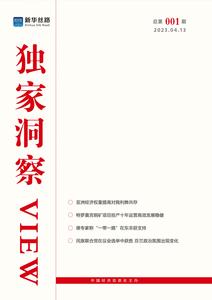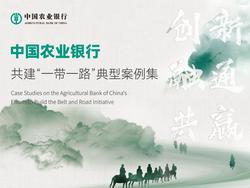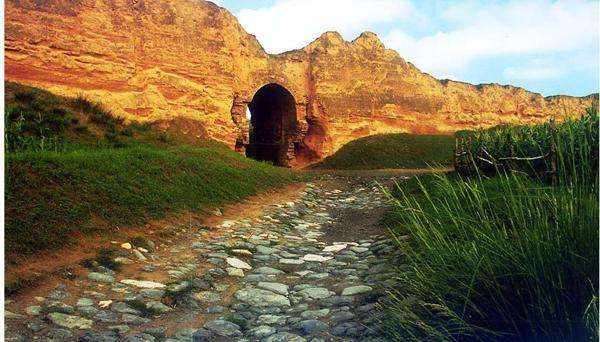
Going to Western Gate, a migration spanning two hundred years, brought Han and Mongolian together. With her broad mind and a heart full of mercy, the city of Ordos accepted both the masses from Jin and Shan along with their farming culture and a period of great historical significance commenced.
In 1697 A.D, which was also the 36th year of Kangxi, the Emperor inspected Ordos region for three times and promoted an open policy, which would allow the peasants from Shanxi and Shaanxi to farm on Mongolian lands. This marked the beginning of a new influx to the Western Gate. Mongolia seemed to be a promising land to peasants fleeing famines. After the Boxer Protocol in late Qing Dynasty, the government decided to reclaim Mongolian lands on larger scale. As a result, the influx of masses from Shanxi and Shaanxi increased more and more. Broadly speaking, influx to Western Gate refers to the masses from Jin and Shan who rushed into Mongolia through the gates of the Great Wall. One of the gates is Shahukou in Youyu County, Shanxi Province, which paved the way into Houtao though Horinger, Mongolia. The other is Fugu County, Shaanxi with the southern side faced inwards and the northern, outwards. Therefore, western gate is both vague and clear, and general and specific. For the masses from northwestern Shanxi and northern Shaanxi, the main route into Ordos was by road, involving Shake Block - Nalin - Machang Trench - Xinmin Fort - Wangaizhao - Shulinzhao - Dashu Bay, to Baotou and other places.
Today, when we enter this route in Ordos, the historic and modern aspects complement each other in richly interesting ways. The eye-catching sceneries make people feel the spectacular integration of Mongolian and Han culture.
After the Boxer Protocol in late Qing Dynasty, the government decided to reclaim Mongolian lands on larger scale. As a result, the influx of masses from Shanxi and Shaanxi increased more and more. Broadly speaking, influx to Western Gate refers to the masses from Jin and Shan who rushed into Mongolia through the gates of the Great Wall. One of the gates is Shahukou in Youyu County, Shanxi Province, which paved the way into Houtao though Horinger, Mongolia. The other is Fugu County, Shaanxi with the southern side faced inwards and the northern, outwards. Therefore, western gate is both vague and clear, and general and specific. For the masses from northwestern Shanxi and northern Shaanxi, the main route into Ordos was by road, involving Shake Block - Nalin - Machang Trench - Xinmin Fort - Wangaizhao - Shulinzhao - Dashu Bay, to Baotou and other places.
Today, when we enter this route in Ordos, the historic and modern aspects complement each other in richly interesting ways. The eye-catching sceneries make people feel the spectacular integration of Mongolian and Han culture.
Mazha, where Longkou’s town government in Jungar County is located, is a vital place for the masses’ entry into Mongolia from southwestern Jin through Hequ. It earned its name due to a bazaar for trade and livestock exchanges. It is still a commercial hub for Jin and Mongolia’s exchange. Mazha is located at the junction of Jin, Shan and Mongolia, and is the lowest land in Ordos. It is an inspiring place with a lot of talented and outstanding people and a variety of fruits. There lived over 50 underground party members before liberation. Longkou Town records and shows Mazha’s shining revolutionary history in Dakou’s party-building exhibition hall.
There has been a road that connects to Hequ, but the villagers still like to take boats to the ferry that travels along the Yellow River between Jin and Mongolia. Many people in Hequ also use the river route to attend Mazhan’s bazaar every 7th, 17th or 27th of a month. Shi Tianrong, a 54-year-old villager in Dakou village, goes boating as his part-time job after farming. His grandfather and father once took a boat at the ferry. Now, if someone wants to take a boat, he is just one call away asking five Chinese dollars for one round trip. “In the past, travelers were mostly poor; therefore, the ferry was half-free. Now, it charges according to the fuel used. Shi Tianrong inherited the tradition of ancient Dakou Ferry. In Longkou Township, the center of the river route, one finds the legendary “Goddess Beach” and “Prince Beach”. They become visible from a long distance and appear as two pearls shining in the Yellow River near Wanjiazhai Water Conservancy Hub and Longkou Water Conservancy Hub. “Goddess Beach” belongs to Hequ in Shanxi, and “Prince Beach” belongs to Jungar, Inner Mongolia. However, it cannot separate this pair of “mother and child”. Longkou Town has put “Goddess Tan” into the Yellow River tourist routes design. For Longkou’s residents, “Goddess Beach” belongs to their town. Today, Longkou Town has become a key construction center in Ordos City, with a new look and a growing economic and social condition. In 2013, Longkou Town pioneered to promote a health insurance system in the autonomous region; going to see a doctor first and then paying for it. In 2014, outpatient number exceeded 60,000 only in Mazhan District.
Towards northwest from Longkou Town comes the ancient city of Fugu in Shaanxi. Li Cunqing, who married into this ancient city from Jungar, started with his family, a small supermarket. In the cave with lanterns stops a Passat and this car’s front is towards the inside. The stiff steps and bitter stories have already passed, and the dusty ancient routes have been replaced with asphalt roads. The route now remains unaffected during rains and it takes only one day to complete a round trip.
After the Boxer Protocol in late Qing Dynasty, the government decided to reclaim Mongolian lands on larger scale. As a result, the influx of masses from Shanxi and Shaanxi increased more and more. Broadly speaking, influx to Western Gate refers to the masses from Jin and Shan who rushed into Mongolia through the gates of the Great Wall. One of the gates is Shahukou in Youyu County, Shanxi Province, which paved the way into Houtao though Horinger, Mongolia. The other is Fugu County, Shaanxi with the southern side faced inwards and the northern, outwards. Therefore, western gate is both vague and clear, and general and specific. For the masses from northwestern Shanxi and northern Shaanxi, the main route into Ordos was by road, involving Shake Block - Nalin - Machang Trench - Xinmin Fort - Wangaizhao - Shulinzhao - Dashu Bay, to Baotou and other places.
Today, when we enter this route in Ordos, the historic and modern aspects complement each other in richly interesting ways. The eye-catching sceneries make people feel the spectacular integration of Mongolian and Han culture.
Mazha, where Longkou’s town government in Jungar County is located, is a vital place for the masses’ entry into Mongolia from southwestern Jin through Hequ. It earned its name due to a bazaar for trade and livestock exchanges. It is still a commercial hub for Jin and Mongolia’s exchange. Mazha is located at the junction of Jin, Shan and Mongolia, and is the lowest land in Ordos. It is an inspiring place with a lot of talented and outstanding people and a variety of fruits. There lived over 50 underground party members before liberation. Longkou Town records and shows Mazha’s shining revolutionary history in Dakou’s party-building exhibition hall.
There has been a road that connects to Hequ, but the villagers still like to take boats to the ferry that travels along the Yellow River between Jin and Mongolia. Many people in Hequ also use the river route to attend Mazhan’s bazaar every 7th, 17th or 27th of a month. Shi Tianrong, a 54-year-old villager in Dakou village, goes boating as his part-time job after farming. His grandfather and father once took a boat at the ferry. Now, if someone wants to take a boat, he is just one call away asking five Chinese dollars for one round trip. “In the past, travelers were mostly poor; therefore, the ferry was half-free. Now, it charges according to the fuel used. Shi Tianrong inherited the tradition of ancient Dakou Ferry. In Longkou Township, the center of the river route, one finds the legendary “Goddess Beach” and “Prince Beach”. They become visible from a long distance and appear as two pearls shining in the Yellow River near Wanjiazhai Water Conservancy Hub and Longkou Water Conservancy Hub. “Goddess Beach” belongs to Hequ in Shanxi, and “Prince Beach” belongs to Jungar, Inner Mongolia. However, it cannot separate this pair of “mother and child”. Longkou Town has put “Goddess Tan” into the Yellow River tourist routes design. For Longkou’s residents, “Goddess Beach” belongs to their town. Today, Longkou Town has become a key construction center in Ordos City, with a new look and a growing economic and social condition. In 2013, Longkou Town pioneered to promote a health insurance system in the autonomous region; going to see a doctor first and then paying for it. In 2014, outpatient number exceeded 60,000 only in Mazhan District.
Towards northwest from Longkou Town comes the ancient city of Fugu in Shaanxi. Li Cunqing, who married into this ancient city from Jungar, started with his family, a small supermarket. In the cave with lanterns stops a Passat and this car’s front is towards the inside. The stiff steps and bitter stories have already passed, and the dusty ancient routes have been replaced with asphalt roads. The route now remains unaffected during rains and it takes only one day to complete a round trip.
In the past, people who went to West Gate advanced northbound along Nalin River after exiting this ancient city. They usually had to stay in a hotel for a night in Jungar. Jungar was named “Meiji County” as it was rich in millet in the Han Dynasty, whose ancient city was in Nalin; a land with rich cultural deposits. Meiji is a farming paradise for the ancient migrants whose praying for harvest was a sacred longing. If one stayed in a hotel in Meiji, it definitely could make travelers full of confidence and courage again. The working masses who went to Western Gate road were mostly craftsmen, therefore handicraft and service industry got more developed. Amongst their products, Nalin’s carpet was most famous. It was exported overseas and is well-known all over the world. However, with the decline in market needs and benefit space, Nalin Carpet Factory closed down in 2002. Now, some of factory workers continue to produce their hand-made carpets in family workshops, and support the traditional handicraft industry.
Bustling Nalin Street remains a bit old charming, in which shops and stores display etiquettes and styles in their purity. There is a busy donkey Wantuoer restaurant in the street offering a typical snack that along with Shanxi and Shaanxi has become a recommendation in Jungar. The female owner of this restaurant is honest and generous. Unexpectedly, in a bowl of donkey wantuoer, there is two thirds of meat. It should be said that Han’ honesty and generosity in Ordos originates from the warm-heartedness and generosity of our Mongolian compatriots. An open-minded, tolerant, honest and friendly Ordos’s spirit Mongolian and Han once developed make us enjoy their benefits till date.
After the Boxer Protocol in late Qing Dynasty, the government decided to reclaim Mongolian lands on larger scale. As a result, the influx of masses from Shanxi and Shaanxi increased more and more. Broadly speaking, influx to Western Gate refers to the masses from Jin and Shan who rushed into Mongolia through the gates of the Great Wall. One of the gates is Shahukou in Youyu County, Shanxi Province, which paved the way into Houtao though Horinger, Mongolia. The other is Fugu County, Shaanxi with the southern side faced inwards and the northern, outwards. Therefore, western gate is both vague and clear, and general and specific. For the masses from northwestern Shanxi and northern Shaanxi, the main route into Ordos was by road, involving Shake Block - Nalin - Machang Trench - Xinmin Fort - Wangaizhao - Shulinzhao - Dashu Bay, to Baotou and other places.
Today, when we enter this route in Ordos, the historic and modern aspects complement each other in richly interesting ways. The eye-catching sceneries make people feel the spectacular integration of Mongolian and Han culture.
Mazha, where Longkou’s town government in Jungar County is located, is a vital place for the masses’ entry into Mongolia from southwestern Jin through Hequ. It earned its name due to a bazaar for trade and livestock exchanges. It is still a commercial hub for Jin and Mongolia’s exchange. Mazha is located at the junction of Jin, Shan and Mongolia, and is the lowest land in Ordos. It is an inspiring place with a lot of talented and outstanding people and a variety of fruits. There lived over 50 underground party members before liberation. Longkou Town records and shows Mazha’s shining revolutionary history in Dakou’s party-building exhibition hall.
There has been a road that connects to Hequ, but the villagers still like to take boats to the ferry that travels along the Yellow River between Jin and Mongolia. Many people in Hequ also use the river route to attend Mazhan’s bazaar every 7th, 17th or 27th of a month. Shi Tianrong, a 54-year-old villager in Dakou village, goes boating as his part-time job after farming. His grandfather and father once took a boat at the ferry. Now, if someone wants to take a boat, he is just one call away asking five Chinese dollars for one round trip. “In the past, travelers were mostly poor; therefore, the ferry was half-free. Now, it charges according to the fuel used. Shi Tianrong inherited the tradition of ancient Dakou Ferry. In Longkou Township, the center of the river route, one finds the legendary “Goddess Beach” and “Prince Beach”. They become visible from a long distance and appear as two pearls shining in the Yellow River near Wanjiazhai Water Conservancy Hub and Longkou Water Conservancy Hub. “Goddess Beach” belongs to Hequ in Shanxi, and “Prince Beach” belongs to Jungar, Inner Mongolia. However, it cannot separate this pair of “mother and child”. Longkou Town has put “Goddess Tan” into the Yellow River tourist routes design. For Longkou’s residents, “Goddess Beach” belongs to their town. Today, Longkou Town has become a key construction center in Ordos City, with a new look and a growing economic and social condition. In 2013, Longkou Town pioneered to promote a health insurance system in the autonomous region; going to see a doctor first and then paying for it. In 2014, outpatient number exceeded 60,000 only in Mazhan District.
Towards northwest from Longkou Town comes the ancient city of Fugu in Shaanxi. Li Cunqing, who married into this ancient city from Jungar, started with his family, a small supermarket. In the cave with lanterns stops a Passat and this car’s front is towards the inside. The stiff steps and bitter stories have already passed, and the dusty ancient routes have been replaced with asphalt roads. The route now remains unaffected during rains and it takes only one day to complete a round trip.
In the past, people who went to West Gate advanced northbound along Nalin River after exiting this ancient city. They usually had to stay in a hotel for a night in Jungar. Jungar was named “Meiji County” as it was rich in millet in the Han Dynasty, whose ancient city was in Nalin; a land with rich cultural deposits. Meiji is a farming paradise for the ancient migrants whose praying for harvest was a sacred longing. If one stayed in a hotel in Meiji, it definitely could make travelers full of confidence and courage again. The working masses who went to Western Gate road were mostly craftsmen, therefore handicraft and service industry got more developed. Amongst their products, Nalin’s carpet was most famous. It was exported overseas and is well-known all over the world. However, with the decline in market needs and benefit space, Nalin Carpet Factory closed down in 2002. Now, some of factory workers continue to produce their hand-made carpets in family workshops, and support the traditional handicraft industry.
Bustling Nalin Street remains a bit old charming, in which shops and stores display etiquettes and styles in their purity. There is a busy donkey Wantuoer restaurant in the street offering a typical snack that along with Shanxi and Shaanxi has become a recommendation in Jungar. The female owner of this restaurant is honest and generous. Unexpectedly, in a bowl of donkey wantuoer, there is two thirds of meat. It should be said that Han’ honesty and generosity in Ordos originates from the warm-heartedness and generosity of our Mongolian compatriots. An open-minded, tolerant, honest and friendly Ordos’s spirit Mongolian and Han once developed make us enjoy their benefits till date.
While going through Western Gate road, what was imported into Ordos is not merely Wantuoer but an integration of farming and grassland civilization shaped by a glorious history of Mongolian and Han. Once Han got into Ordos, they and lower Mongolian would be under oppressive exploitation from Mongolian aristocrats and Han land agents. It was the class structure that united Mongolian and Han. Military anti-reclamation and Duguilang movements were co-sponsored by the same Mongolian and Han.
In Ordos, going to West Gate road turned a single animal husbandry economy into a combined economy of agriculture and animal husbandry.Their mutual help in production and influence on each other’s lives made Mongolian and Han gradually integrate into one identity. Their living habits, values, pursuit of humanism and other aspects became closer and in accord. Han widely accepted Tibetan Buddhism that Mongolian believed. Mongolian started to worship Dragon King and Guan Emperor. The Han liked fried rice, milk tea and hand-grilled meat, and Mongolian loved to eat powder soup, fried cake and sauerkraut. After integration Mongolian and Han, a new characteristic culture was formed. They together created melodies such as “Manhan tune”. Now, Jungar County has been named by the Ministry of Culture as a town of Chinese Folk Culture and Art and a Manhan Tune Festival is held every three years. Manhan tune is enduring in Ordos’s folk tradition. For the classic repertoire “boat fishing" that was popular in Dalate County, its melody prototype was Mongolian folk song “Zhamingzhahan”. Got associated with “boat fishing” popular in Dalate County, and then got incorporated in Shanxi and Shaanxi folk music. Typically, it can be said by “Boat Fishing” that the essence of Manhan tune is “Meng-Han tune”.
Machang Trench in Dalate County was once an important rally point along the Western Gate road. There are two large carriage and horse hotels over there. The Trench provided a place to craftsmen for taking rest. The paper-making workshops and firework stores were extremely popular in the area. Now, like most of rural areas in the city, young people go out while the elderly stay at home in the village. Speaking of the Manhan Tune, Zhang Weizhu, a village secretary of the party, says: “Any of us can sing it. “Every Saturday and Sunday, the village holds a performance among villagers in the committee yard”. After town-combination policy, Machang Trench was merged into Jigesitai Town. The local government built comprehensive service center in order to solve the villagers’ problems. In the north of Machang Trench is a vast alluvial plane of Yellow River; there is a song “sea and the sea flows over Miliang River” in “Boat Fishing. In this Bailiang River, Bainijing modern agriculture Demonstration Park, as a shiny pearl, represents highest level in development of farming civilization in Ordos.
After the Boxer Protocol in late Qing Dynasty, the government decided to reclaim Mongolian lands on larger scale. As a result, the influx of masses from Shanxi and Shaanxi increased more and more. Broadly speaking, influx to Western Gate refers to the masses from Jin and Shan who rushed into Mongolia through the gates of the Great Wall. One of the gates is Shahukou in Youyu County, Shanxi Province, which paved the way into Houtao though Horinger, Mongolia. The other is Fugu County, Shaanxi with the southern side faced inwards and the northern, outwards. Therefore, western gate is both vague and clear, and general and specific. For the masses from northwestern Shanxi and northern Shaanxi, the main route into Ordos was by road, involving Shake Block - Nalin - Machang Trench - Xinmin Fort - Wangaizhao - Shulinzhao - Dashu Bay, to Baotou and other places.
Today, when we enter this route in Ordos, the historic and modern aspects complement each other in richly interesting ways. The eye-catching sceneries make people feel the spectacular integration of Mongolian and Han culture.
Mazha, where Longkou’s town government in Jungar County is located, is a vital place for the masses’ entry into Mongolia from southwestern Jin through Hequ. It earned its name due to a bazaar for trade and livestock exchanges. It is still a commercial hub for Jin and Mongolia’s exchange. Mazha is located at the junction of Jin, Shan and Mongolia, and is the lowest land in Ordos. It is an inspiring place with a lot of talented and outstanding people and a variety of fruits. There lived over 50 underground party members before liberation. Longkou Town records and shows Mazha’s shining revolutionary history in Dakou’s party-building exhibition hall.
There has been a road that connects to Hequ, but the villagers still like to take boats to the ferry that travels along the Yellow River between Jin and Mongolia. Many people in Hequ also use the river route to attend Mazhan’s bazaar every 7th, 17th or 27th of a month. Shi Tianrong, a 54-year-old villager in Dakou village, goes boating as his part-time job after farming. His grandfather and father once took a boat at the ferry. Now, if someone wants to take a boat, he is just one call away asking five Chinese dollars for one round trip. “In the past, travelers were mostly poor; therefore, the ferry was half-free. Now, it charges according to the fuel used. Shi Tianrong inherited the tradition of ancient Dakou Ferry. In Longkou Township, the center of the river route, one finds the legendary “Goddess Beach” and “Prince Beach”. They become visible from a long distance and appear as two pearls shining in the Yellow River near Wanjiazhai Water Conservancy Hub and Longkou Water Conservancy Hub. “Goddess Beach” belongs to Hequ in Shanxi, and “Prince Beach” belongs to Jungar, Inner Mongolia. However, it cannot separate this pair of “mother and child”. Longkou Town has put “Goddess Tan” into the Yellow River tourist routes design. For Longkou’s residents, “Goddess Beach” belongs to their town. Today, Longkou Town has become a key construction center in Ordos City, with a new look and a growing economic and social condition. In 2013, Longkou Town pioneered to promote a health insurance system in the autonomous region; going to see a doctor first and then paying for it. In 2014, outpatient number exceeded 60,000 only in Mazhan District.
Towards northwest from Longkou Town comes the ancient city of Fugu in Shaanxi. Li Cunqing, who married into this ancient city from Jungar, started with his family, a small supermarket. In the cave with lanterns stops a Passat and this car’s front is towards the inside. The stiff steps and bitter stories have already passed, and the dusty ancient routes have been replaced with asphalt roads. The route now remains unaffected during rains and it takes only one day to complete a round trip.
In the past, people who went to West Gate advanced northbound along Nalin River after exiting this ancient city. They usually had to stay in a hotel for a night in Jungar. Jungar was named “Meiji County” as it was rich in millet in the Han Dynasty, whose ancient city was in Nalin; a land with rich cultural deposits. Meiji is a farming paradise for the ancient migrants whose praying for harvest was a sacred longing. If one stayed in a hotel in Meiji, it definitely could make travelers full of confidence and courage again. The working masses who went to Western Gate road were mostly craftsmen, therefore handicraft and service industry got more developed. Amongst their products, Nalin’s carpet was most famous. It was exported overseas and is well-known all over the world. However, with the decline in market needs and benefit space, Nalin Carpet Factory closed down in 2002. Now, some of factory workers continue to produce their hand-made carpets in family workshops, and support the traditional handicraft industry.
Bustling Nalin Street remains a bit old charming, in which shops and stores display etiquettes and styles in their purity. There is a busy donkey Wantuoer restaurant in the street offering a typical snack that along with Shanxi and Shaanxi has become a recommendation in Jungar. The female owner of this restaurant is honest and generous. Unexpectedly, in a bowl of donkey wantuoer, there is two thirds of meat. It should be said that Han’ honesty and generosity in Ordos originates from the warm-heartedness and generosity of our Mongolian compatriots. An open-minded, tolerant, honest and friendly Ordos’s spirit Mongolian and Han once developed make us enjoy their benefits till date.
While going through Western Gate road, what was imported into Ordos is not merely Wantuoer but an integration of farming and grassland civilization shaped by a glorious history of Mongolian and Han. Once Han got into Ordos, they and lower Mongolian would be under oppressive exploitation from Mongolian aristocrats and Han land agents. It was the class structure that united Mongolian and Han. Military anti-reclamation and Duguilang movements were co-sponsored by the same Mongolian and Han.
In Ordos, going to West Gate road turned a single animal husbandry economy into a combined economy of agriculture and animal husbandry.Their mutual help in production and influence on each other’s lives made Mongolian and Han gradually integrate into one identity. Their living habits, values, pursuit of humanism and other aspects became closer and in accord. Han widely accepted Tibetan Buddhism that Mongolian believed. Mongolian started to worship Dragon King and Guan Emperor. The Han liked fried rice, milk tea and hand-grilled meat, and Mongolian loved to eat powder soup, fried cake and sauerkraut. After integration Mongolian and Han, a new characteristic culture was formed. They together created melodies such as “Manhan tune”. Now, Jungar County has been named by the Ministry of Culture as a town of Chinese Folk Culture and Art and a Manhan Tune Festival is held every three years. Manhan tune is enduring in Ordos’s folk tradition. For the classic repertoire “boat fishing" that was popular in Dalate County, its melody prototype was Mongolian folk song “Zhamingzhahan”. Got associated with “boat fishing” popular in Dalate County, and then got incorporated in Shanxi and Shaanxi folk music. Typically, it can be said by “Boat Fishing” that the essence of Manhan tune is “Meng-Han tune”.
Machang Trench in Dalate County was once an important rally point along the Western Gate road. There are two large carriage and horse hotels over there. The Trench provided a place to craftsmen for taking rest. The paper-making workshops and firework stores were extremely popular in the area. Now, like most of rural areas in the city, young people go out while the elderly stay at home in the village. Speaking of the Manhan Tune, Zhang Weizhu, a village secretary of the party, says: “Any of us can sing it. “Every Saturday and Sunday, the village holds a performance among villagers in the committee yard”. After town-combination policy, Machang Trench was merged into Jigesitai Town. The local government built comprehensive service center in order to solve the villagers’ problems. In the north of Machang Trench is a vast alluvial plane of Yellow River; there is a song “sea and the sea flows over Miliang River” in “Boat Fishing. In this Bailiang River, Bainijing modern agriculture Demonstration Park, as a shiny pearl, represents highest level in development of farming civilization in Ordos.
The passing travelers on roads left their own marks in Dalate County. In Wanaiuzhao Town, there is a village named “Three Thatched Huts”, which earned its name due to the huts that were made by travelers on the Western Gate road while taking breaks. “Xinmin Fort”, an important distribution center on the Western Gate road, was funded and built by seven families (He, Xie, Wu, Mi, Bai, Cheng and Qiao) who reached Dalate at that time.
Although there have been a few soil embankments left for the 1.8-zhang walls, the neat design of three streets and six lanes can still be seen. Standing besides the ruin, He Quan, a He's descendant, remains full of pride while talking about Xinmin Fort at that time: “In the past, it was grander than Baotou”. The Wangaizhao people have 300,000 Mu of farmland and have developed farming industry with such characteristics that their per capita income grows year by year. Now, they are actively rebuilding DongZang, Wangaizhao, and are creating a rural eco-tourism zone with production and management, leisure and entertainment, sightseeing and experience.
Today, Ordos creates one modern industrial civilization along the Western Gate roads. Three key industrial parks in the city, Jungar Economic Development Zone, Dalu Coal Chemical Industry Base and Dalate Economic Development Zone, prop up the eastern modern industrial framework in Ordos. Industrial sales in 2015 were more than 10 billion Yuan, respectively, 26.1 billion, 10 billion, and 35 billion. The industry covers metallurgy, coal, construction material, ceramics, and joint production of coal, electricity and aluminum and so on. On the Western Gate route, railways and roads appear in cross-laced mode, and the chain in modern cycle industry grows longer.
The West Gate Road was full of bitterness and hardships but found its way to glory of civilization. It is a channel for integration and sublimation in farming and grassland culture, and a bridge for Mongolian and the Han to build their friendship co-creating a civilization. The spiritual quality, open-mindedness, tolerance, integrity, friendliness, perseverance, struggle and innovation, hard-work and progress, have been co-fostered by Mongolian and Han. The new culture took roots and flourished in the vast lands of Ordos and is transforming into a regional civilization of exemplary characteristics.
After the Boxer Protocol in late Qing Dynasty, the government decided to reclaim Mongolian lands on larger scale. As a result, the influx of masses from Shanxi and Shaanxi increased more and more. Broadly speaking, influx to Western Gate refers to the masses from Jin and Shan who rushed into Mongolia through the gates of the Great Wall. One of the gates is Shahukou in Youyu County, Shanxi Province, which paved the way into Houtao though Horinger, Mongolia. The other is Fugu County, Shaanxi with the southern side faced inwards and the northern, outwards. Therefore, western gate is both vague and clear, and general and specific. For the masses from northwestern Shanxi and northern Shaanxi, the main route into Ordos was by road, involving Shake Block - Nalin - Machang Trench - Xinmin Fort - Wangaizhao - Shulinzhao - Dashu Bay, to Baotou and other places.
Today, when we enter this route in Ordos, the historic and modern aspects complement each other in richly interesting ways. The eye-catching sceneries make people feel the spectacular integration of Mongolian and Han culture.
Mazha, where Longkou’s town government in Jungar County is located, is a vital place for the masses’ entry into Mongolia from southwestern Jin through Hequ. It earned its name due to a bazaar for trade and livestock exchanges. It is still a commercial hub for Jin and Mongolia’s exchange. Mazha is located at the junction of Jin, Shan and Mongolia, and is the lowest land in Ordos. It is an inspiring place with a lot of talented and outstanding people and a variety of fruits. There lived over 50 underground party members before liberation. Longkou Town records and shows Mazha’s shining revolutionary history in Dakou’s party-building exhibition hall.
There has been a road that connects to Hequ, but the villagers still like to take boats to the ferry that travels along the Yellow River between Jin and Mongolia. Many people in Hequ also use the river route to attend Mazhan’s bazaar every 7th, 17th or 27th of a month. Shi Tianrong, a 54-year-old villager in Dakou village, goes boating as his part-time job after farming. His grandfather and father once took a boat at the ferry. Now, if someone wants to take a boat, he is just one call away asking five Chinese dollars for one round trip. “In the past, travelers were mostly poor; therefore, the ferry was half-free. Now, it charges according to the fuel used. Shi Tianrong inherited the tradition of ancient Dakou Ferry. In Longkou Township, the center of the river route, one finds the legendary “Goddess Beach” and “Prince Beach”. They become visible from a long distance and appear as two pearls shining in the Yellow River near Wanjiazhai Water Conservancy Hub and Longkou Water Conservancy Hub. “Goddess Beach” belongs to Hequ in Shanxi, and “Prince Beach” belongs to Jungar, Inner Mongolia. However, it cannot separate this pair of “mother and child”. Longkou Town has put “Goddess Tan” into the Yellow River tourist routes design. For Longkou’s residents, “Goddess Beach” belongs to their town. Today, Longkou Town has become a key construction center in Ordos City, with a new look and a growing economic and social condition. In 2013, Longkou Town pioneered to promote a health insurance system in the autonomous region; going to see a doctor first and then paying for it. In 2014, outpatient number exceeded 60,000 only in Mazhan District.
Towards northwest from Longkou Town comes the ancient city of Fugu in Shaanxi. Li Cunqing, who married into this ancient city from Jungar, started with his family, a small supermarket. In the cave with lanterns stops a Passat and this car’s front is towards the inside. The stiff steps and bitter stories have already passed, and the dusty ancient routes have been replaced with asphalt roads. The route now remains unaffected during rains and it takes only one day to complete a round trip.
In the past, people who went to West Gate advanced northbound along Nalin River after exiting this ancient city. They usually had to stay in a hotel for a night in Jungar. Jungar was named “Meiji County” as it was rich in millet in the Han Dynasty, whose ancient city was in Nalin; a land with rich cultural deposits. Meiji is a farming paradise for the ancient migrants whose praying for harvest was a sacred longing. If one stayed in a hotel in Meiji, it definitely could make travelers full of confidence and courage again. The working masses who went to Western Gate road were mostly craftsmen, therefore handicraft and service industry got more developed. Amongst their products, Nalin’s carpet was most famous. It was exported overseas and is well-known all over the world. However, with the decline in market needs and benefit space, Nalin Carpet Factory closed down in 2002. Now, some of factory workers continue to produce their hand-made carpets in family workshops, and support the traditional handicraft industry.
Bustling Nalin Street remains a bit old charming, in which shops and stores display etiquettes and styles in their purity. There is a busy donkey Wantuoer restaurant in the street offering a typical snack that along with Shanxi and Shaanxi has become a recommendation in Jungar. The female owner of this restaurant is honest and generous. Unexpectedly, in a bowl of donkey wantuoer, there is two thirds of meat. It should be said that Han’ honesty and generosity in Ordos originates from the warm-heartedness and generosity of our Mongolian compatriots. An open-minded, tolerant, honest and friendly Ordos’s spirit Mongolian and Han once developed make us enjoy their benefits till date.
While going through Western Gate road, what was imported into Ordos is not merely Wantuoer but an integration of farming and grassland civilization shaped by a glorious history of Mongolian and Han. Once Han got into Ordos, they and lower Mongolian would be under oppressive exploitation from Mongolian aristocrats and Han land agents. It was the class structure that united Mongolian and Han. Military anti-reclamation and Duguilang movements were co-sponsored by the same Mongolian and Han.
In Ordos, going to West Gate road turned a single animal husbandry economy into a combined economy of agriculture and animal husbandry.Their mutual help in production and influence on each other’s lives made Mongolian and Han gradually integrate into one identity. Their living habits, values, pursuit of humanism and other aspects became closer and in accord. Han widely accepted Tibetan Buddhism that Mongolian believed. Mongolian started to worship Dragon King and Guan Emperor. The Han liked fried rice, milk tea and hand-grilled meat, and Mongolian loved to eat powder soup, fried cake and sauerkraut. After integration Mongolian and Han, a new characteristic culture was formed. They together created melodies such as “Manhan tune”. Now, Jungar County has been named by the Ministry of Culture as a town of Chinese Folk Culture and Art and a Manhan Tune Festival is held every three years. Manhan tune is enduring in Ordos’s folk tradition. For the classic repertoire “boat fishing" that was popular in Dalate County, its melody prototype was Mongolian folk song “Zhamingzhahan”. Got associated with “boat fishing” popular in Dalate County, and then got incorporated in Shanxi and Shaanxi folk music. Typically, it can be said by “Boat Fishing” that the essence of Manhan tune is “Meng-Han tune”.
Machang Trench in Dalate County was once an important rally point along the Western Gate road. There are two large carriage and horse hotels over there. The Trench provided a place to craftsmen for taking rest. The paper-making workshops and firework stores were extremely popular in the area. Now, like most of rural areas in the city, young people go out while the elderly stay at home in the village. Speaking of the Manhan Tune, Zhang Weizhu, a village secretary of the party, says: “Any of us can sing it. “Every Saturday and Sunday, the village holds a performance among villagers in the committee yard”. After town-combination policy, Machang Trench was merged into Jigesitai Town. The local government built comprehensive service center in order to solve the villagers’ problems. In the north of Machang Trench is a vast alluvial plane of Yellow River; there is a song “sea and the sea flows over Miliang River” in “Boat Fishing. In this Bailiang River, Bainijing modern agriculture Demonstration Park, as a shiny pearl, represents highest level in development of farming civilization in Ordos.
The passing travelers on roads left their own marks in Dalate County. In Wanaiuzhao Town, there is a village named “Three Thatched Huts”, which earned its name due to the huts that were made by travelers on the Western Gate road while taking breaks. “Xinmin Fort”, an important distribution center on the Western Gate road, was funded and built by seven families (He, Xie, Wu, Mi, Bai, Cheng and Qiao) who reached Dalate at that time.
Although there have been a few soil embankments left for the 1.8-zhang walls, the neat design of three streets and six lanes can still be seen. Standing besides the ruin, He Quan, a He's descendant, remains full of pride while talking about Xinmin Fort at that time: “In the past, it was grander than Baotou”. The Wangaizhao people have 300,000 Mu of farmland and have developed farming industry with such characteristics that their per capita income grows year by year. Now, they are actively rebuilding DongZang, Wangaizhao, and are creating a rural eco-tourism zone with production and management, leisure and entertainment, sightseeing and experience.
Today, Ordos creates one modern industrial civilization along the Western Gate roads. Three key industrial parks in the city, Jungar Economic Development Zone, Dalu Coal Chemical Industry Base and Dalate Economic Development Zone, prop up the eastern modern industrial framework in Ordos. Industrial sales in 2015 were more than 10 billion Yuan, respectively, 26.1 billion, 10 billion, and 35 billion. The industry covers metallurgy, coal, construction material, ceramics, and joint production of coal, electricity and aluminum and so on. On the Western Gate route, railways and roads appear in cross-laced mode, and the chain in modern cycle industry grows longer.
The West Gate Road was full of bitterness and hardships but found its way to glory of civilization. It is a channel for integration and sublimation in farming and grassland culture, and a bridge for Mongolian and the Han to build their friendship co-creating a civilization. The spiritual quality, open-mindedness, tolerance, integrity, friendliness, perseverance, struggle and innovation, hard-work and progress, have been co-fostered by Mongolian and Han. The new culture took roots and flourished in the vast lands of Ordos and is transforming into a regional civilization of exemplary characteristics.
As Western Gate Road reflects great achievements and emits brilliant radiance, Ordos promises a vibrant future!
